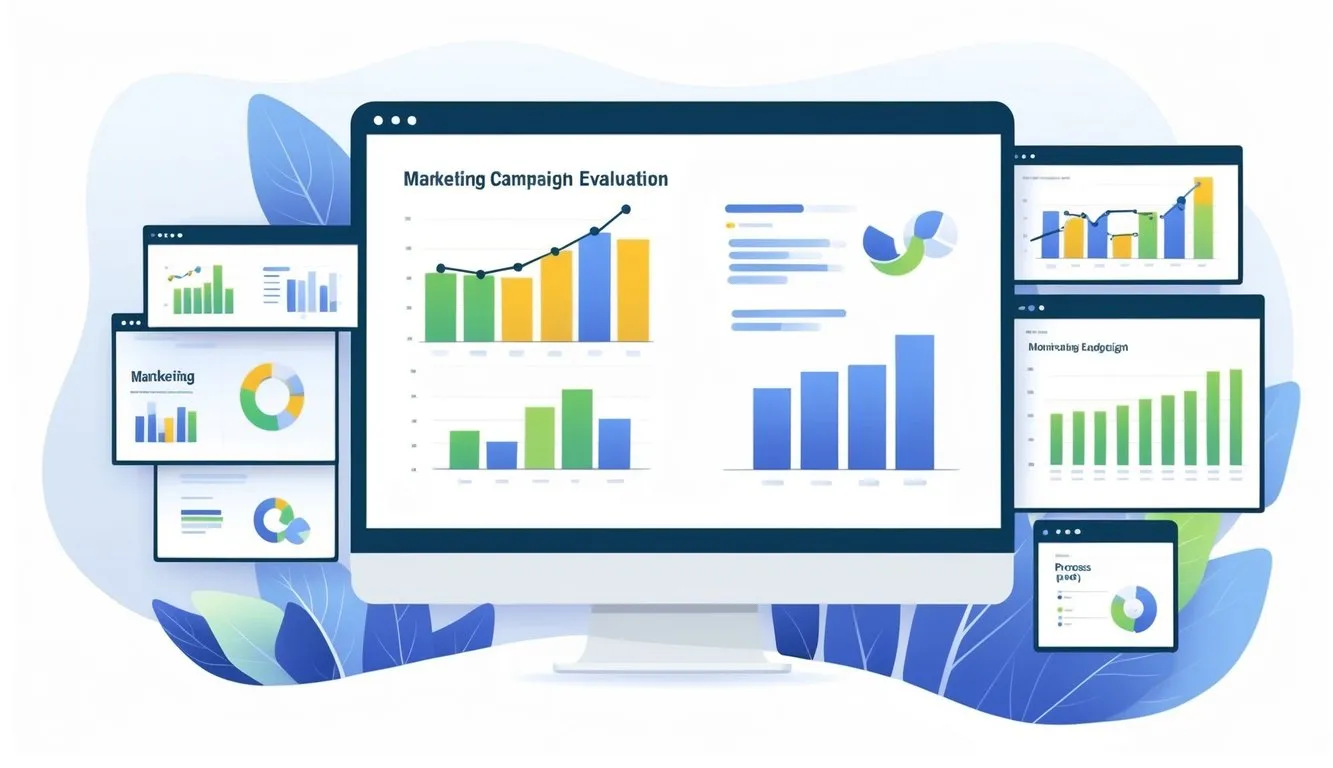Ever struggled to tell if your marketing campaigns are actually working?
Many businesses throw money at marketing without knowing if their efforts bring real results.
A solid marketing campaign evaluation process helps you measure your performance, pinpoint what works, and make data-driven decisions to improve future campaigns.
Measuring your marketing success doesn’t need to be complicated.
With the right approach, you can easily track your progress and see the impact of your strategies. The key is having a step-by-step method that looks at the right metrics for your specific goals.
So if you’re running digital ads, social media campaigns, or content marketing, proper evaluation gives you clarity on your return on investment.
By setting clear objectives from the start and consistently tracking your performance, you’ll stop guessing and start knowing exactly how effective your marketing truly is.
Knowing Your Marketing Goals

Clear goals form the foundation of successful marketing campaigns. They guide your strategy, help measure success, and ensure your marketing efforts contribute to business growth.
Setting SMART Goals
SMART goals make your marketing plan actionable and measurable. Each letter in SMART represents a critical element:
- Specific: Define exactly what you want to achieve
- Measurable: Include metrics to track progress
- Achievable: Set realistic targets based on resources
- Relevant: Align with your broader business objectives
- Time-bound: Set clear deadlines for completion
For example, instead of “increase website traffic,” a SMART goal would be “increase organic website traffic by 25% within 3 months by publishing 8 SEO-optimized blog posts.”
Tracking progress regularly helps you adjust tactics when needed.
Use digital analytics tools to monitor key metrics like conversion rates, click-through rates, and engagement metrics that directly relate to your goals.
Aligning Campaigns with Business Goals
Your marketing campaigns must support your larger business objectives. This alignment ensures you’re not just creating buzz but driving real business results.
Start by identifying your primary business goals. Are you aiming to:
- Increase revenue by 15%?
- Enter a new market segment?
- Improve customer retention?
Then design campaigns that directly contribute to these goals.
If your business aims to boost customer loyalty, your marketing goal might focus on increasing repeat purchases or improving satisfaction scores.
Create a clear connection between marketing activities and business outcomes. This helps justify marketing spend and demonstrates the value of your efforts to stakeholders.
Remember to communicate these goals across teams to ensure everyone works toward the same targets.
Developing the Marketing Plan
A solid marketing plan sets the foundation for your campaign success. It provides direction, aligns your team, and creates a roadmap for achieving your business goals.
Conducting Market Research
Market research gives you critical insights into your industry landscape. Start by gathering both primary and secondary data about your market.
Primary research includes:
- Customer surveys
- Focus groups
- Interviews with potential customers
- Sales data analysis
Secondary research involves reviewing:
- Industry reports
- Competitor websites
- Market trend publications
- Social media conversations
Use tools like Google Trends, SEMrush, and social listening platforms to track what people are saying about your industry.
Set specific goals for your research to stay focused.
Pay attention to pricing strategies, distribution channels, and promotional tactics used by competitors. This information helps you identify gaps in the market that your product can fill.
Remember to document all findings systematically. Create a simple spreadsheet to track key data points for easy reference later in the planning process.
Identifying Target Audiences
Your marketing efforts will fall flat without a clear picture of who you’re trying to reach.
Take time to create detailed buyer personas based on demographics, psychographics, and behavior patterns.
Ask these critical questions:
- Who benefits most from your product/service?
- What problems do they need solved?
- Where do they spend their time online and offline?
- How do they make purchasing decisions?
Break down your audience into primary and secondary segments.
Primary segments offer immediate revenue potential, while secondary segments represent future growth opportunities.
Target customer identification should also consider the decision-making process. Know if you’re marketing to the end-user, the purchaser, or an influencer in the buying process.
Use this information to tailor your messaging and channel strategy. Different audience segments respond to different types of content and communication styles.
Formulating a Value Proposition
Your value proposition answers the critical question: “Why should customers choose you over competitors?”
It must be clear, compelling, and customer-focused.
A strong value proposition includes:
- The specific problem you solve
- How your solution is different
- Tangible benefits customers will experience
Avoid generic statements like “best quality” or “excellent service.”
Instead, be specific: “Reduces inventory costs by 23% through automated tracking.”
Test your value proposition by asking if it’s:
- Specific and measurable
- Focused on customer outcomes
- Different from what competitors offer
Your value proposition should guide all marketing materials. Every piece of content should reinforce this core message about your unique value.
Position your business clearly in the market based on this value proposition. This positioning determines how customers perceive your brand relative to alternatives.
Creating a SWOT Analysis
A SWOT analysis examines your Strengths, Weaknesses, Opportunities, and Threats.
This framework helps you assess internal factors you control and external factors you must respond to.
Strengths: What do you do better than competitors? Consider:
- Unique technology or processes
- Strong brand recognition
- Exclusive partnerships
- Expertise in specific areas
Weaknesses: Where might you fall short? Be honest about:
- Resource limitations
- Knowledge gaps
- Product limitations
- Market position challenges
Opportunities: What external factors could help you succeed?
- Emerging market trends
- Competitor weaknesses
- New technologies
- Changing regulations
Threats: What external forces could hinder success?
- New competitors
- Shifting customer preferences
- Economic downturns
- Supply chain disruptions
The SWOT framework helps you evaluate your marketing budget and allocation. Direct resources toward leveraging strengths and opportunities while addressing critical weaknesses and threats.
Review your SWOT analysis regularly as market conditions change. What was once a strength might become a weakness if you don’t adapt to evolving customer needs.
Executing and Tracking the Campaign

Successful campaign execution requires strategic planning and consistent monitoring. The following steps will help you implement your marketing campaign effectively while measuring its impact.
Choosing Marketing Strategies
Select marketing strategies that align with your campaign goals and target audience.
Digital marketing offers multiple channels like email marketing, paid advertising, and content marketing that can be tailored to your needs.
Consider your audience’s behavior patterns when selecting strategies. If your target customers spend significant time on social media, prioritize those platforms.
For B2B campaigns, LinkedIn and email marketing might yield better results than Instagram.
Create a strategy mix that balances immediate returns with long-term growth. Marketing campaign management requires both quick-win tactics and sustained efforts that build brand awareness over time.
Test different approaches on a small scale before full implementation. This saves resources and provides valuable data about what works best for your specific audience.
Leveraging Social Media and Influencers
Social media platforms offer targeted reach at relatively low costs. Choose platforms where your audience is most active rather than trying to maintain a presence everywhere.
Influencer partnerships can amplify your message through trusted voices. Select influencers whose followers match your target demographic and whose personal brand aligns with your values.
Create platform-specific content rather than posting identical messages across all channels. Each platform has unique features and audience expectations that require customized approaches.
Track engagement metrics like shares, comments, and click-through rates to gauge performance.
Social media platforms provide robust analytics tools that help you measure the effectiveness of your marketing campaign.
Set up a content calendar to maintain consistent posting schedules and coordinate messaging across platforms.
Allocating the Marketing Budget
You want to distribute your budget based on expected return on investment from each channel. High-performing channels deserve larger allocations, but always reserve some funds for testing new approaches.
Build flexibility into your budget to adapt to campaign performance data. Be prepared to shift resources from underperforming channels to those showing promise.
Track spending in real time to prevent budget overruns. Many digital platforms allow you to set daily or campaign-total spending limits to maintain control.
Consider seasonality and timing when planning expenditures. Some periods may require higher spending to capitalize on increased consumer activity or competitive opportunities.
Use attribution modeling to understand which channels drive conversions. This helps you track marketing campaigns more effectively and optimize future budget allocations.
Utilizing SEO and Content Marketing
Develop SEO-optimized content that addresses your audience’s questions and needs. Research relevant keywords and incorporate them naturally into your content.
Create a variety of content types including blog posts, videos, infographics, and podcasts. Different formats appeal to different segments of your audience and serve various stages of the buyer journey.
Implement technical SEO best practices like proper meta descriptions, alt tags, and mobile optimization.
These elements improve visibility in search results and enhance user experience.
Measure content performance through metrics like organic traffic, time on page, and conversion rates. These indicators help you refine your content strategy over time.
Build a consistent publishing schedule to establish authority in your niche. Regular content updates signal to search engines that your site is active and relevant, improving rankings over time.
Metrics and Analytics for Evaluation

Tracking the right numbers helps you know if your marketing campaign is working. The data you collect shows where to make changes and what’s already performing well.
Understanding Key Metrics
Key metrics give you a clear picture of your campaign’s performance. Not all metrics matter equally for every campaign.
Click-Through Rate (CTR) shows how many people clicked your ad compared to how many saw it. A higher rate means your message resonates with your audience.
Conversion Rate measures how many visitors completed your desired action. This could be making a purchase, signing up for emails, or downloading content.
Customer Acquisition Cost (CAC) tells you how much you spend to get one new customer. Calculate it by dividing your total campaign cost by the number of new customers gained.
Return on Investment (ROI) is crucial for proving campaign value. The formula is simple:
ROI = (Net Profit / Total Cost) × 100
Focus on metrics that align with your specific goals. This prevents getting lost in data that doesn’t matter to your objectives.
Using Google Analytics
Google Analytics gives you powerful insights into your campaign performance. Set it up properly to track the right data from the start.
Create UTM parameters for all campaign links. These special codes help you track where your traffic comes from. Make them consistent across all marketing channels.
Set up conversion goals in your Analytics account. This lets you track specific actions visitors take on your site, from form submissions to product purchases.
Use the Acquisition reports to see which traffic sources bring the most valuable visitors. Compare channels like organic search, paid ads, social media, and email.
The Behavior reports show what people do on your site. Look at pages with high bounce rates to find content that needs improvement.
Audience reports help you understand who visits your site. This data helps refine your targeting for future campaigns.
Measuring Engagement and Conversions
Engagement metrics show how people interact with your content. This includes time on page, social shares, comments, and repeat visits.
Set up proper tracking for all conversion points. Use Google Tag Manager to monitor form submissions, button clicks, and other important user actions.
Compare engagement across different channels. Some platforms naturally have higher engagement rates than others.
Social media metrics require special attention. Look beyond likes to shares, comments, and click-throughs. These actions show deeper engagement.
Email marketing metrics like open rate and click rate reveal campaign effectiveness. A good benchmark for open rates is 15-25% depending on your industry.
Remember that different channels require different evaluation approaches. What works for social media won’t apply to email or paid search.
Always tie engagement back to business results. High engagement is only valuable if it leads to conversions that matter to your business.
Analyzing Results and ROI
After running your marketing campaign, you need to measure how well it performed.
Looking at data helps you understand what worked and what didn’t, so you can make smarter decisions next time.
Evaluating Campaign Reach and Impact
Reach shows how many people saw your marketing message. Track this through impressions, clicks, and engagement across all channels.
Compare your reach metrics against your initial goals. Did you hit your target audience numbers?
Look at engagement rates to understand impact. High click-through rates usually indicate your message resonated with viewers.
Social media analytics provide valuable insights into how people interacted with your content. Check shares, comments, and saves.
Website traffic patterns tell you if your campaign drove actual visits. Use UTM parameters to track which specific ads brought visitors to your site.
Don’t forget about Cost Per Click (CPC) – a lower CPC means more efficient spending.
Calculating Return on Investment
ROI tells you if your marketing dollars generated profit. The basic formula is:
ROI = (Revenue from Campaign – Campaign Cost) / Campaign Cost × 100%
Start by tracking all expenses related to your campaign:
- Ad spend
- Content creation costs
- Staff time
- Tools and software
- Agency fees
Then measure the revenue directly attributed to your campaign. Use conversion tracking and sales data to connect purchases to specific marketing efforts.
A positive ROI means your campaign made money. Most successful campaigns aim for at least 5:1 return (500% ROI).
Break down ROI by channel to identify your most profitable platforms. This helps you better allocate your budget next time.
Assessing Customer Lifetime Value
Customer Lifetime Value (CLV) looks beyond immediate sales to measure long-term campaign impact. It represents the total revenue you can expect from a customer over your entire relationship.
Calculate basic CLV using this formula:
CLV = Average Purchase Value × Purchase Frequency × Average Customer Lifespan
A high CLV justifies higher acquisition costs. You can spend more to attract customers who will generate revenue for years.
Compare CLV across different customer segments. Which types of customers bring the most long-term value?
Track how your marketing campaign affected CLV. Did it bring in one-time buyers or loyal customers?
Use KPIs to monitor these long-term relationships. Retention rate, repeat purchase rate, and average order value all contribute to CLV.
Adjust your marketing strategy based on CLV findings. Focus resources on campaigns that attract high-value, long-term customers.
Making Data-Driven Decisions
Turning campaign data into actionable insights requires systematic analysis, competitive comparison, and strategic planning.
When done right, this process transforms raw numbers into clear direction for your marketing efforts.
Performing Data Analysis
Data analysis is the foundation of informed marketing decisions. Start by collecting all relevant campaign metrics from your analytics platforms. Focus on:
- Conversion rates across different channels
- Engagement metrics like click-through rates and time on page
- Cost per acquisition for each customer segment
- ROI by marketing channel and creative
Use visualization tools to identify patterns in your data. Simple charts or graphs can reveal trends that might be missed in spreadsheets.
Cross-reference your findings with your initial campaign goals. Did you reach your target KPIs?
Transform your data into meaningful insights by asking specific questions: Which channels delivered the best results? What messaging resonated most with your audience?
Break down performance by demographics to understand which segments responded best to your campaign. This granular analysis helps you identify your most valuable customers.
Benchmarking Against Competitors
Competitive benchmarking puts your campaign results in context. Identify 3-5 direct competitors whose marketing efforts target similar audiences.
Track their:
| Benchmark Area | What to Measure |
|---|---|
| Content strategy | Posting frequency, engagement rates |
| Ad performance | Estimated ad spend, creative approaches |
| Social presence | Follower growth, engagement per post |
| SEO ranking | Keywords they dominate, backlink profile |
Use competitive intelligence tools to gather data legally and ethically. These insights reveal gaps in your strategy and opportunities to differentiate.
Pay special attention to competitors who excel with limited budgets. Their efficiency tactics often provide valuable lessons for resource optimization.
Remember that benchmarking isn’t about copying competitors but understanding market standards. Your goal is to find your unique advantage in the competitive landscape.
Formulating Strategic Recommendations
Turn your analysis into clear, actionable recommendations. Prioritize suggestions based on:
- Impact potential – Which changes will drive the biggest improvements?
- Resource requirements – What can you implement with your current budget and team?
- Timeline – Which actions deliver quick wins versus long-term growth?
Create a recommendation matrix that connects each insight to specific actions. For example, if data shows email outperforms social media, recommend shifting budget accordingly.
Be specific with your recommendations: “Increase email frequency to twice weekly for segment A” rather than “improve email marketing.”
Address underperforming media channels directly. Sometimes the best recommendation is to discontinue efforts that drain resources without adequate returns.
Tailor your recommendations to your target market’s behaviors. The first step in data-driven marketing is understanding what motivates your specific audience segments.
Finally, present your findings and recommendations in a concise format that busy stakeholders can quickly grasp and act upon.
 Domain SearchInstantly check and register your preferred domain name
Domain SearchInstantly check and register your preferred domain name Web Hosting
Web Hosting cPanel HostingHosting powered by cPanel (Most user friendly)
cPanel HostingHosting powered by cPanel (Most user friendly) KE Domains
KE Domains Reseller HostingStart your own hosting business without tech hustles
Reseller HostingStart your own hosting business without tech hustles Windows HostingOptimized for Windows-based applications and sites.
Windows HostingOptimized for Windows-based applications and sites. Free Domain
Free Domain Affiliate ProgramEarn commissions by referring customers to our platforms
Affiliate ProgramEarn commissions by referring customers to our platforms Free HostingTest our SSD Hosting for free, for life (1GB storage)
Free HostingTest our SSD Hosting for free, for life (1GB storage) Domain TransferMove your domain to us with zero downtime and full control
Domain TransferMove your domain to us with zero downtime and full control All DomainsBrowse and register domain extensions from around the world
All DomainsBrowse and register domain extensions from around the world .Com Domain
.Com Domain WhoisLook up domain ownership, expiry dates, and registrar information
WhoisLook up domain ownership, expiry dates, and registrar information VPS Hosting
VPS Hosting Managed VPSNon techy? Opt for fully managed VPS server
Managed VPSNon techy? Opt for fully managed VPS server Dedicated ServersEnjoy unmatched power and control with your own physical server.
Dedicated ServersEnjoy unmatched power and control with your own physical server. SupportOur support guides cover everything you need to know about our services
SupportOur support guides cover everything you need to know about our services






